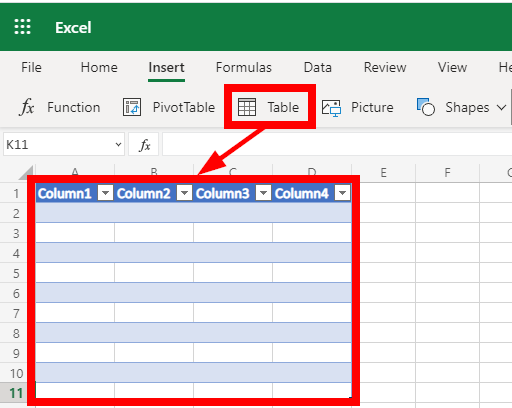Microsoft 365 Excel (Action Flow)
Important
Any references to third-party products or services do not constitute Celonis Product Documentation nor do they create any contractual obligations. This material is for informational purposes only and is subject to change without notice.
Celonis does not warrant the availability, accuracy, reliability, completeness, or usefulness of any information regarding the subject of third-party services or systems.
The Microsoft 365 Excel modules enable you to monitor workbooks and rows or retrieve, add, update, or delete worksheets, rows, and tables in your Microsoft 365 Excel account.
To get started with Microsoft 365 Excel app, create an account at office.com.
Refer to the Microsoft Graph REST API documentation for the list of available endpoints.
Connect Microsoft 365 Excel to Celonis platform
To connect to the Excel app:
Log in to your Celonis platform account, add any Microsoft 365 Excel module Action Flow, and click the Add button next to the Connection field.
Optional: In the Connection name field, enter a name in the connection.
Optional: Click Show advanced settings to enter your custom app client credentials and add additional scopes as needed.
For more information about the permissions, see the Microsoft Graph permissions reference.
Click Save.
If prompted, log in to your Microsoft account and confirm the access.
You have successfully connected the app and can now build Action Flows.
Build Microsoft 365 Excel Action Flows
After connecting the app, you can perform the following actions:
Workbook
Keyword Query Language
Use Keyword Query Language (KQL) search syntax to build your search queries in Microsoft modules. For more information, see Microsoft Graph help.
Watch Workbooks
Required Permissions: offline_access, User.Read, Files.Read.All
Search Workbooks
Required Permissions: offline_access, User.Read, Files.Read.All
Download a Workbook
Required Permissions: offline_access, User.Read, Files.ReadWrite, Files.Read.All
Worksheet
Watch Worksheet Rows
Required Permissions: offline_access, User.Read, Files.ReadWrite, Files.Read.All
List Worksheets
Required Permissions: offline_access, User.Read, Files.ReadWrite, Files.Read.All
List Worksheet Rows
Required Permissions: offline_access, User.Read, Files.ReadWrite, Files.Read.All
Add a Worksheet
Required Permissions: offline_access, User.Read, Files.ReadWrite, Files.Read.All
Add a Worksheet Row
Required Permissions: offline_access, User.Read, Files.ReadWrite, Files.Read.All
Update a Worksheet Row
Required Permissions: offline_access, User.Read, Files.ReadWrite, Files.Read.All
Delete a Worksheet Row
Required Permissions: offline_access, User.Read, Files.ReadWrite, Files.Read.All
Table
Watch Table Rows
Required Permissions: offline_access, User.Read, Files.ReadWrite, Files.Read.All
List Tables
Required Permissions: offline_access, User.Read, Files.ReadWrite, Files.Read.All
List Table Rows
Required Permissions: offline_access, User.Read, Files.ReadWrite, Files.Read.All
Get a Table
Required Permissions: offline_access, User.Read, Files.ReadWrite, Files.Read.All
Add a Table
To use tables, see Add a Table
Add a Table Row
Required Permissions: offline_access, User.Read, Files.ReadWrite, Files.Read.All
Add a Table Column
Required Permissions: offline_access, User.Read, Files.ReadWrite, Files.Read.All
Update a Table
Required Permissions: offline_access, User.Read, Files.ReadWrite, Files.Read.All
Update a Table Column
Required Permissions: offline_access, User.Read, Files.ReadWrite, Files.Read.All
Delete a Table
Required Permissions: offline_access, User.Read, Files.ReadWrite, Files.Read.All
Other
Note
When using these modules in the Microsoft 365 Excel integration, there is a maximum limit of 3300 records per request. This limit is set to prevent service interruptions and ensure optimal performance during data retrieval operations.
Retrieve Data
Required Permissions: offline_access, User.Read, Files.ReadWrite, Files.Read.All
Make an API Call
Required Permissions: offline_access, User.Read
Table
The table here refers to the embedded table element in the Workbook. Not the entire table (workbook/worksheet).

Adds a new table.
Required Permissions: Files.ReadWrite, Files.Read.All
Connection | |
Update a Table | Select the option to choose the |
Workbook ID | Enter the Workbook ID to whose worksheet you want to add a table. |
Workbook | Select or map the workbook you want to use. |
Worksheet | Select the Excel sheet you want to add a table to. |
Has Headers | If you select this checkbox, the first defined row will be used as the table headers.  |
Address | Set the size of the table. For example, |
Add a Table - Files.ReadWrite, Files.Read.All, offline_access, User.Read
Add a Table Row - Files.ReadWrite, Files.Read.All, offline_access, User.Read
Add a Worksheet - Files.ReadWrite, Files.Read.All, offline_access, User.Read
Add a Worksheet Row - Files.ReadWrite, Files.Read.All, offline_access, User.Read
Add/Update a Worksheet Row (Advanced) - Files.ReadWrite, offline_access, User.Read
Delete a Table - Files.ReadWrite, Files.Read.All, offline_access, User.Read
Delete a Worksheet Row - Files.ReadWrite, Files.Read.All, offline_access, User.Read
Download a Workbook - Files.ReadWrite, Files.Read.All, offline_access, User.Read
Get a Table - Files.ReadWrite, Files.Read.All, offline_access, User.Read
List Table Rows - Files.ReadWrite, Files.Read.All, offline_access, User.Read
List Tables - Files.ReadWrite, Files.Read.All, offline_access, User.Read
List Worksheet Rows - Files.ReadWrite, Files.Read.All, offline_access, User.Read
List Worksheets - Files.ReadWrite, Files.Read.All, offline_access, User.Read
Retrieve Data - Files.ReadWrite, Files.Read.All, offline_access, User.Read
Search Workbooks - Files.Read.All, offline_access, User.Read
Update a Table - Files.ReadWrite, Files.Read.All, offline_access, User.Read
Update a Worksheet Row - Files.ReadWrite, Files.Read.All, offline_access, User.Read
Watch Workbooks - Files.Read.All, offline_access, User.Read
Watch Worksheet Rows - Files.ReadWrite, Files.Read.All, offline_access, User.Read